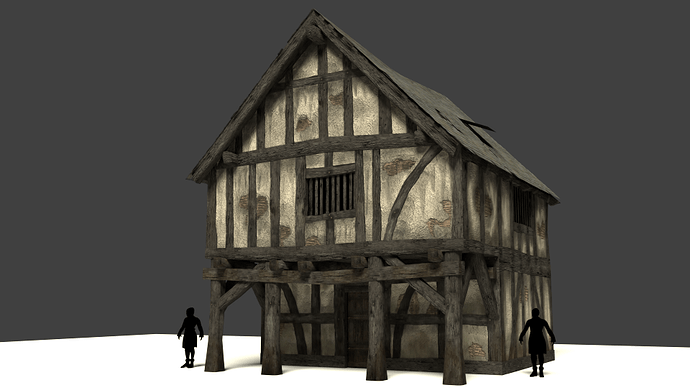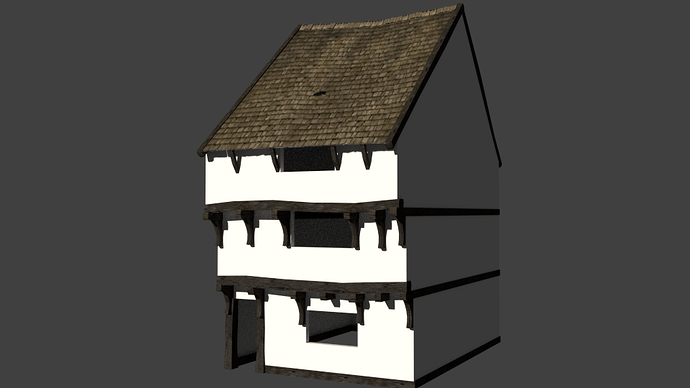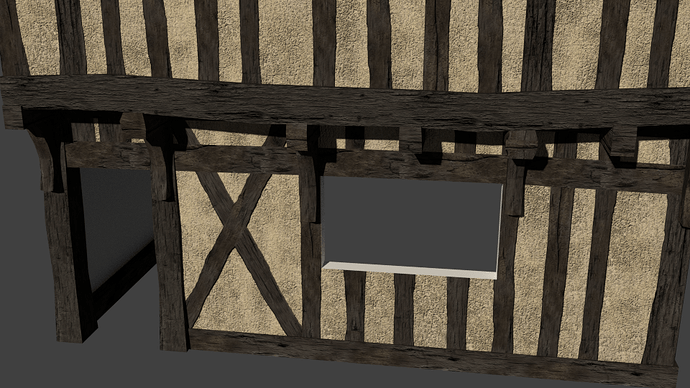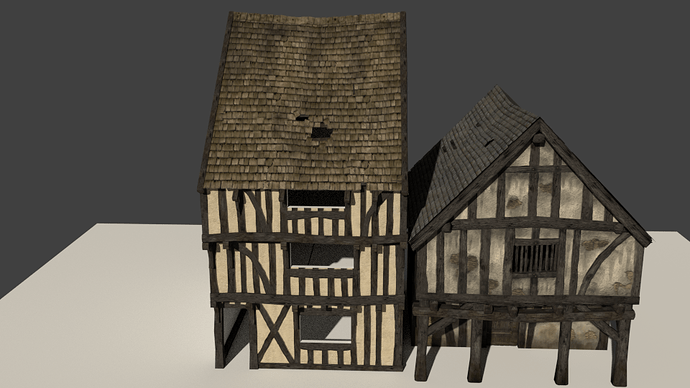Yeah, it was pretty much a town thing (to gain more room - since many medieval cities developed out of old Roman towns and many roads were closed with long-stretched houses). The more you talk about that house the more I want to see it. I will specialise on Medieval houses one day and teach that stuff at university haha. And beams sizes varied greatly, I guess, but I read somewhere that after the 16th century they started to use smaller pieces for the big trees from which they made big beams were all-gone. Now I don’t know whether that’s true, half-true or it’s something made up, but if you look at late Tudor houses you will notice many smaller timber pieces in the frame.http://www.blackandwhitehouses.co.uk/images/black&white2.gifsmall.jpg
if i remember well most of the good wood in the EU was almost gone around the 12 Centurie
and they began importing it from all over the world!
UK was importing a lot of big Oak from The new America colonie around 16 Centurie
big business for building navy ships
But i’m bit surprise that these wood beams lasted so long
must have been treated with some good stuff!
happy cycles
How much work is it usually to retrofit these old homes with electricity and all the stuff needed for today’s technology, I’d hazard to guess that someone had to find a way to put in such basic things as plumbing (considering how everything in my part of the world is less than 150 years old).
Some of the texture work here so far is top notch and in cases goes a ways in offsetting the low-poly look, I await to see where you will go with this.
Very Beautyfull work manorial !
I use to like very much all this, but on my own par i model large spaces like this one:
http://kleioscope.fr/projets/rupellaXIII/index.html
It’s far less accurate and beautifull than yours but is intended for realtime rendering.
thanks for your work !
Thanks for the replies guys. In fact, England was importing timber from Scandinavia and Germany, though forests still existed (they belonged to the monarchy although people were sometimes allowed to fetch timber for housing in there). I believe they treated timber with something, (that might be why it assumed that blackish colour - again, I read that somewhere, am not sure about it though). @pitibonom: thanks, your work seems to be awesome. I saw the image of the castle and it looks really nice, though it did not load the video (?). If you put it on youtube you would have loads of views! And is it possible to import models rendered in cycles into unity? I’d like to model a few more houses and make them explorable.
I have added human figures to give an idea of proportions. The two men in the render are 1.72 cm tall (5’6"), average height (for men) in XIV century England.
Attachments
Oh would be great !
In fact it’s not a video but a kind of game online. You can freely move in the medieval town ( like you can do in FPS games )
I also put a lil ( crappy ) video on the homepage of my website: http://kleioscope.fr
Hopelessly, i was too lazy to write it in english. It’s in french.
For moving in the 3D, you need an explorer ( unfortunately if you’re under linux it won’t work as-is. Then tell me and i’ll give you a link
for using it with wine, then emulation a windows environment. ) with the installed Unity3D webplayer plugin.
The plugin automatically loads the 3D data and shows it off in a FPS-like way.
Yes, Blender is damn finely integrated in unity and all i did was in unity, with mesh & UV editing in blender. The workflow is pretty smooth and nice to work with.
If you do some thingies with unity please lemme know  i’d be really interrested in it !
i’d be really interrested in it !
Lil question: how many tris is you haouse you posted in the prev post please ?
regards and congratz again for you great work !
EDIT: for unity & blender, you have nevertheless to be very carefull with triangles count and textures sizes. Because what is possible at blender render time is not always at unity render time. Blender renders 1 frame per minute, and unity is intended to render up to 100s frames per second 
Thanks for your wide answer! I will definitely let you know. How does transparency work in Unity? Do I need to script stuff? And the house is roughly 800 polygons.
My house isn’t really a good architectural example, it’s been so altered over the years, though it didn’t get plumbing and electricity until after WWII. There are strict rules about how they do that in an old building; they generally run wires and pipes along the outside of the interior walls (not the most attractive thing, if it isn’t done well). It became so run down at one point, the shepherds wouldn’t use it for shelter, and it was almost pulled down in the early 20th C (Mermaid Street almost was, too. Google “Mermaid Street Rye” to see how sad that would have been).
Britain was one big forest at one time. If you missed it, Manorial, you’d probably really enjoy the BBC series Carved With Love, a three-parter about woodwork. You can still get it on iPlayer.
ANYway, back to the model. Are you modeling the structural members as individual objects, or are the houses basically cubes with UV textures applied? If you’re doing it for the encyclopedia idea, you’d be better building it like a real structure, with lots of individual bits, so you could do cutaways and exploded views and things. But if the idea is to put together a whole city and walk through it, textured boxes would make your life a lot easier.
You’re right, in case I did a single model for an Encyclopaedia (as I shall do one day) I would model every single part. In this case though I am keeping the model as low-poly as possible, and the timber beams take the majority of the poly. Some of the beams are part of the texture (gave them shadow in PS) while others have been modelled, to break the otherwise unavoidable straightness of the edges. The real nightmare will be modelling stone walls without displacement maps (which take billions of poly).
Hi manorial.
In unity, transparency is handled as-is through built-in shaders, using the alpha channel in rgba textures.
800 polys for the house ! it’s pretty good ! definitely real-time game-rdy models !
For stones, don’t use displacement but normal maps instead. it’s handled in hardware in all 3D boards today, wich is not
the cas of displacement maps ( though blender handles them ).
In unity, of course you can use normalmaps you created in PS or gimp through some plugins ( the ones that generate those pink-bluish
strange textures with red & green on relief edges ) or also creat in PS/Gimp some heightmap in grey levels and press the button called create bumpmap in unity.
now… i can’t wait ! please, provide us with some others of you beautifull models !!! 
have nice blends !
Very first preview of what will be the second house of the scene, a three storey timber framed building.
Attachments
If you’re going to be manually building each house with no reuse of components, then it’s going to take a while before it really starts to look like a town. (of course it can bring a very high level of quality, but only if you’re planning on making this a long-term project).
Though I do like the small imperfections you’re making here, holes in the shingles, a crooked beam, stained walls, though I wouldn’t try to make the town look too much like a dump considering you want to show an authentic historical setting.
Thanks for the positive comment, Ace. You’re indeed right, it would take a very long time to build a whole city; the project is to create an explorable medieval street with some 6-7 detailed buildings, and send it the University of Edinburgh and London for an accuracy examination. After that, we may think of modelling an entire small town, but that might be done in the future. You’re also right about the excessive bad conditions of the houses, I will model some in a slightly better status. However, houses away from the main thoroughfares were likely to be in a precarious condition, since they would belong to less wealthy citizens who had neither the means nor the time to fix them. Anyway, thanks for the comment, I will definitely keep that in mind since we want it to be as realistic as possible.
how many houses are we talking here?
if there is a lot can it becone with proxy may be?
and can this work wiht cycles ?
are you going for high res or low res like game modeling
happy cycles
I think the scene will be made of 6-7 houses or maybe more, a narrow street with buildings on each side. I am rendering the models in cycles, but the whole thing will be transferred into Unity and then you will all enjoy a walk into a XIV century medieval town street. I am keeping the models low poly (1000 poly per house circa), and am using textures to enhance the details






